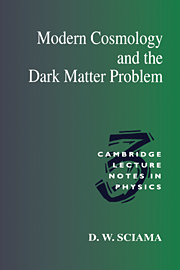Book contents
- Frontmatter
- Contents
- Preface
- Recent Developments
- Part One Dark Matter in Astronomy and Cosmology
- Part Two Ionisation Problems in Astronomy and Cosmology
- 5 Diffuse Ionisation in the Milky Way
- 6 Diffuse Ionisation in Spiral Galaxies
- 7 The Intergalactic Flux of Hydrogen-Ionising Photons
- Part Three Neutrino Decay and Ionisation in the Universe
- Part Four Observational Searches for the Neutrino Decay Line
- References
- Subject index
6 - Diffuse Ionisation in Spiral Galaxies
Published online by Cambridge University Press: 11 January 2010
- Frontmatter
- Contents
- Preface
- Recent Developments
- Part One Dark Matter in Astronomy and Cosmology
- Part Two Ionisation Problems in Astronomy and Cosmology
- 5 Diffuse Ionisation in the Milky Way
- 6 Diffuse Ionisation in Spiral Galaxies
- 7 The Intergalactic Flux of Hydrogen-Ionising Photons
- Part Three Neutrino Decay and Ionisation in the Universe
- Part Four Observational Searches for the Neutrino Decay Line
- References
- Subject index
Summary
Introduction
We saw in the last chapter that the Milky Way contains diffuse ionised gas (DIG) with a large scale height. We also saw that there is strong, but not decisive, evidence that conventional sources in the Galaxy are not adequate to account for the observed ionisation. What seem to be needed are sources which are smoothly distributed, so that the opacity of the neutral hydrogen can be overcome, and which possess a large enough scale height to account for the large scale height of the DIG. Dark matter neutrinos in the Galaxy would be expected to possess both these properties, as we discuss in detail in the next part of this book. If the radiative decay of these neutrinos is to be a serious candidate for the ionization source of the DIG in our Galaxy, we would expect to find the same ionisation problems in nearby galaxies whose structure is similar to ours. This is the subject of the present chapter.
There is one advantage and one disadvantage in studying the ionisation in other galaxies. The advantage is that by observing from a point outside the galaxies it is easier to discover the global properties of the ionisation. The disadvantage is that pulsars are not observable in other galaxies (except the Magellanic Clouds), so that we cannot use the pulsar dispersion measure to determine the distribution of the electron density, and have to rely on measurements of Hα and other emission lines. As we shall see, it has been possible by these means to observe the DIG in nearby galaxies and to discover that conventional ionisation sources in these galaxies again seem to be inadequate.
- Type
- Chapter
- Information
- Modern Cosmology and the Dark Matter Problem , pp. 95 - 99Publisher: Cambridge University PressPrint publication year: 1994



